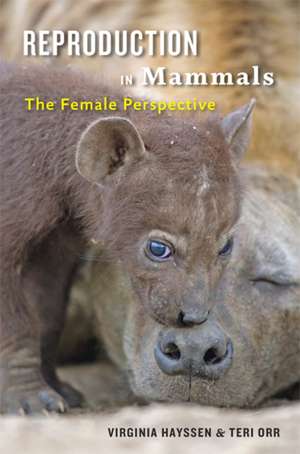Reproduction in Mammals – The Female Perspective
Autor Virginia Hayssen, Teri J. Orren Limba Engleză Hardback – 6 noi 2017
In Reproduction in Mammals, Virginia Hayssen and Teri J. Orr present readers with a fascinating examination of the varied reproductive strategies of a broad spectrum of mammals, from marsupials to whales. This unique book's comprehensive coverage gathers stories from many taxa into a single, cohesive perspective that centers on the reproductive lives of females. The authors shed light on a number of intriguing questions, including
- do bigger moms have bigger babies?
- do primates have longer pregnancies than other groups?
- does habitat influence animals' reproductive patterns?
- do carnivores typically produce larger litters than prey species?
The book opens with the authors' definition of what constitutes a female perspective and an examination of the evolution of reproduction in mammals. It then outlines the typical individual mammalian female: her genetics, anatomy, and physiology. Taking a nuanced approach, Hayssen and Orr describe the female reproductive cycle and explore female mammals' interactions with males and offspring. Readers will come away from this thought-provoking book with an understanding of not only how reproduction fits into the lives of female mammals but also how biology has affected the enormously diverse reproductive patterns of the phenotypes we observe today.
Preț: 442.69 lei
Preț vechi: 546.54 lei
-19% Nou
Puncte Express: 664
Preț estimativ în valută:
84.74€ • 92.07$ • 71.22£
84.74€ • 92.07$ • 71.22£
Carte tipărită la comandă
Livrare economică 21 aprilie-05 mai
Preluare comenzi: 021 569.72.76
Specificații
ISBN-13: 9781421423159
ISBN-10: 1421423154
Pagini: 368
Dimensiuni: 180 x 261 x 26 mm
Greutate: 0.86 kg
Editura: Johns Hopkins University Press
ISBN-10: 1421423154
Pagini: 368
Dimensiuni: 180 x 261 x 26 mm
Greutate: 0.86 kg
Editura: Johns Hopkins University Press
Descriere
Readers will come away from this thought-provoking book with an understanding of not only how reproduction fits into the lives of female mammals but how biology has affected the enormously diverse reproductive patterns of the phenotypes we observe today.
